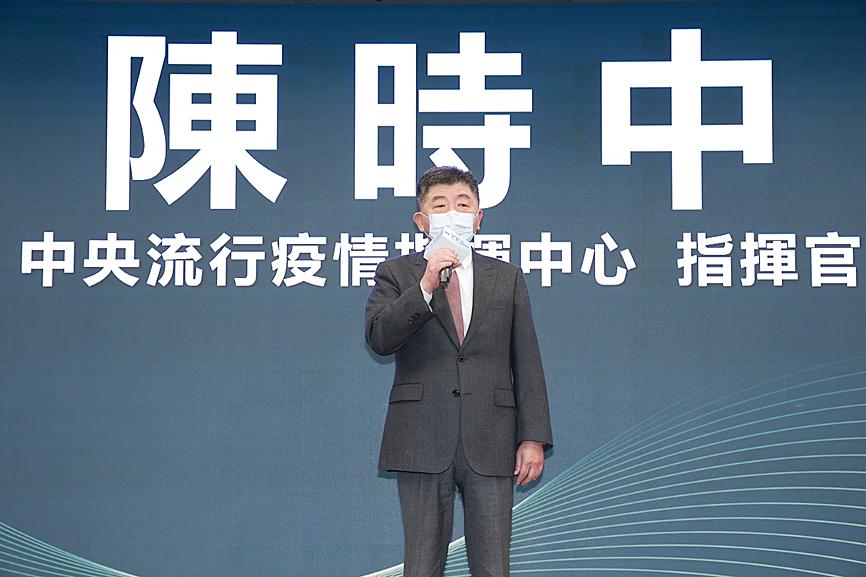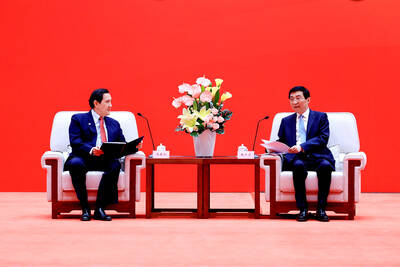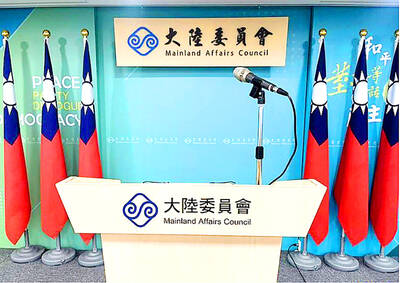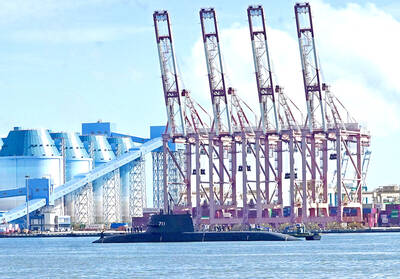The world should have a clearer picture of the Omicron variant of SARS-CoV-2 after the Lunar New Year holiday, Minister of Health and Welfare Chen Shih-chung (陳時中) said yesterday.
Chen, who heads the Central Epidemic Command Center (CECC), made the remark at a ceremony in Taipei at which 79 frontline disease prevention establishments received awards for their contributions to fighting the COVID-19 pandemic.
Last year, Taiwan was “more scared than hurt” by the pandemic, “went through terrifying waves” this year and “the calm after the storm” would hopefully come next year, Chen said.

Photo: CNA
Thanks to border controls, and quarantine and isolation measures, there were 252 continuous days with no new local infections last year, but clusters and a local outbreak this year harmed Taiwanese society, he said.
The center is extremely grateful for the cooperation from all members of society that helped Taiwan bring the local COVID-19 situation under control, Chen said, but added that just as Taiwan is about to catch its breath ahead of the Lunar New Year holidays, the world now faces the Omicron variant.
If the Delta and the Omicron variants continue to dominate worldwide, the world would have a clearer picture of the impact of the Omicron variant in about a month, he said.
As for Taiwan, the picture would be clearer after the holiday starting late next month, he added.
However, as the COVID-19 situation is hard to predict and new variants could emerge at any time, people should strictly follow the CECC’s quarantine and self-health management rules, especially as many Taiwanese return from abroad ahead of the holiday, he said.
Separately yesterday, Centers for Disease Control Deputy Director-General Chuang Jen-hsiang (莊人祥), the CECC’s spokesman, said that there were no new local infections or deaths yesterday, but 18 new imported cases.
They arrived from Cambodia, France, Italy, the Netherlands, Pakistan, Vietnam, the United Arab Emirates and the US, he said.
Chuang said that a locally transmitted COVID-19 case reported on Dec. 9 — a former researcher at Academia Sinica — had not infected any of her listed contacts.
As of Friday, they had all tested negative, and the CECC considers the sitution over, he said.
One-hundred-and-ten close contacts had been placed under isolation, 36 potential contacts were ordered to practice self-health management and 337 people had to practice self-health monitoring, Chen said.
CECC data on Friday showed that Taiwan’s first-dose COVID-19 vaccination rate was 79.76 percent and the full vaccination rate was 66.95 percent, while only 0.4 percent of the population had received a booster shot.
The CECC on Dec. 2 launched booster shots for immunocompromised people and those who received their second dose at least five months earlier, he said, adding that until Friday, boosters had been administered to 231 immunocompromised people and 11,249 third-dose recipients.

CHIP WAR: The new restrictions are expected to cut off China’s access to Taiwan’s technologies, materials and equipment essential to building AI semiconductors Taiwan has blacklisted Huawei Technologies Co (華為) and Semiconductor Manufacturing International Corp (SMIC, 中芯), dealing another major blow to the two companies spearheading China’s efforts to develop cutting-edge artificial intelligence (AI) chip technologies. The Ministry of Economic Affairs’ International Trade Administration has included Huawei, SMIC and several of their subsidiaries in an update of its so-called strategic high-tech commodities entity list, the latest version on its Web site showed on Saturday. It did not publicly announce the change. Other entities on the list include organizations such as the Taliban and al-Qaeda, as well as companies in China, Iran and elsewhere. Local companies need

CRITICISM: It is generally accepted that the Straits Forum is a CCP ‘united front’ platform, and anyone attending should maintain Taiwan’s dignity, the council said The Mainland Affairs Council (MAC) yesterday said it deeply regrets that former president Ma Ying-jeou (馬英九) echoed the Chinese Communist Party’s (CCP) “one China” principle and “united front” tactics by telling the Straits Forum that Taiwanese yearn for both sides of the Taiwan Strait to move toward “peace” and “integration.” The 17th annual Straits Forum yesterday opened in Xiamen, China, and while the Chinese Nationalist Party’s (KMT) local government heads were absent for the first time in 17 years, Ma attended the forum as “former KMT chairperson” and met with Chinese People’s Political Consultative Conference Chairman Wang Huning (王滬寧). Wang

CROSS-STRAIT: The MAC said it barred the Chinese officials from attending an event, because they failed to provide guarantees that Taiwan would be treated with respect The Mainland Affairs Council (MAC) on Friday night defended its decision to bar Chinese officials and tourism representatives from attending a tourism event in Taipei next month, citing the unsafe conditions for Taiwanese in China. The Taipei International Summer Travel Expo, organized by the Taiwan Tourism Exchange Association, is to run from July 18 to 21. China’s Taiwan Affairs Office spokeswoman Zhu Fenglian (朱鳳蓮) on Friday said that representatives from China’s travel industry were excluded from the expo. The Democratic Progressive Party government is obstructing cross-strait tourism exchange in a vain attempt to ignore the mainstream support for peaceful development

DEFENSE: The US would assist Taiwan in developing a new command and control system, and it would be based on the US-made Link-22, a senior official said The Ministry of National Defense is to propose a special budget to replace the military’s currently fielded command and control system, bolster defensive resilience and acquire more attack drones, a senior defense official said yesterday. The budget would be presented to the legislature in August, the source said on condition of anonymity. Taiwan’s decade-old Syun An (迅安, “Swift Security”) command and control system is a derivative of Lockheed Martin’s Link-16 developed under Washington’s auspices, they said. The Syun An system is difficult to operate, increasingly obsolete and has unresolved problems related to integrating disparate tactical data across the three branches of the military,